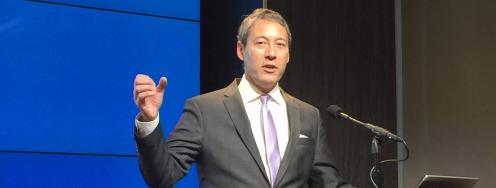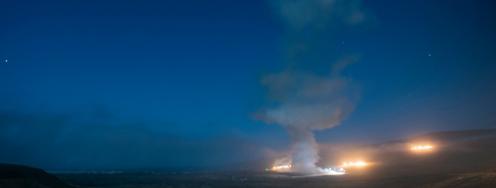Test Ban Sensors Detect Radioactivity from North Korea’s Latest Test
On the radar: Monitors and models; Trident or troops; Taking N. Korea at its word; Countryman on Iran & NPT; PrepCom App; Lessons from Al-Kibar; and Why Tsarnaev is charged with using WMD.
On the radar: Monitors and models; Trident or troops; Taking N. Korea at its word; Countryman on Iran & NPT; PrepCom App; Lessons from Al-Kibar; and Why Tsarnaev is charged with using WMD.
April 23, 2013 | Edited by Benjamin Loehrke and Alyssa Demus
CTBT monitoring - The Comprehensive Nuclear Test-Ban Treaty Organization’s radionuclide network detected radioactive noble gases that could be attributed to North Korea’s February 12 nuclear test. Seismic and infrasound monitoring sensors immediately detected the North’s February test, though this new radionuclide data would add confidence to the nuclear nature of the North’s explosion.
--Wonky details: ”The ratio of the detected xenon isotopes is consistent with a nuclear fission event occurring more than 50 days before the detection...This coincides very well with announced nuclear test by the DPRK that occurred 55 days before the measurement. Using Atmospheric Transport Modelling (ATM), which calculates the three-dimensional travel path of airborne radioactivity on the basis of weather data, the DPRK test site was identified as a possible source for the emission,” reports the CTBTO Preparatory Commission. Details here. http://owl.li/kl2Oy
Tweet - @ctbto_alerts: Radioactive xenon detected near North Korea - video with interviews / animation. http://owl.li/kl09A
Welcome to Early Warning - Subscribe to our morning email or follow us on twitter.
--Have a tip or feedback for the editor? Email earlywarning@ploughshares.org earlywarning@ploughshares.org. Want to support this work? Click here.
Nukes or troops - The United Kingdom is struggling to replace its nuclear deterrent and field a modern military under tightening defense budgets. This is forcing some hard choices upon the UK. “The situation in Britain is so bad that American officials are quietly urging it to drop its expensive nuclear deterrent. ‘Either they can be a nuclear power and nothing else or a real military partner,’ a senior American official said.” Steven Erlanger of The New York Times has the story. http://nyti.ms/Zirim3
Quote - “We’ve been spending money for decades on maintaining nuclear warheads that everyone knows will never be launched. That money could have been better used just about anywhere else,” said Rep. Raúl Grijalva in an op-ed on cutting military spending. Full article in The Tucson Sentinel. http://bit.ly/ZlMqZH
On second thought - The recent hullabaloo over North Korea’s ability to put a nuclear warhead on an ICBM made some in the Pentagon and intelligence community clarify that “North Korea has not yet demonstrated the full range of capabilities necessary for a nuclear armed missile.” Jeffrey Lewis asks, “Why are we demanding that they show us each and every little increment of progress? Do we really want them to put a live nuclear warhead on a Musudan and fire it over Japan just to shut us up?”
--Lewis also looks at the testing history of existing nuclear powers, reminding that it wasn’t so long ago that the Chinese put a live warhead in a missile and fired it across China to prove that a warhead could survive the rough and tumble of delivery by ballistic missile. Full post at Foreign Policy. http://atfp.co/12aFBZr
Tweet - @Reuters: U.S. rejects North Korea's demand for nuclear status. reut.rs/10aEAN0
View from Geneva - Iran’s nuclear program is the biggest threat to the “credibility” of the Non-Proliferation Treaty (NPT), said Assistant Secretary Thomas Countryman at the NPT Preparatory Committee convening in Geneva.
--"The actions of Iran and North Korea should concern every member of this conference. It is clear that if Iran succeeds in the project of constructing nuclear weapons, then it is not only the Helsinki meeting that becomes irrelevant, but it is in fact the entire credibility of this treaty,” said Countryman. Stephanie Nebehay at Reuters has the story. http://owl.li/kl6UN
NPT PrepCom resource - The James Martin Center for Nonproliferation Studies launched a new online resource for the NPT PrepCom, “Featuring live updates from the PrepCom, visuals on nuclear nonproliferation, analysis, articles, and documents related to the 2013 Nuclear Non-Proliferation Treaty (NPT) Review Process.” http://bit.ly/ZitOIZ
--You can also download the mobile app. http://my.yapp.us/ACQWVC
Longread - “Lessons of the Syrian Reactor” by Bruce Riedel in The National Interest.
--In April 2007, Israel told the Bush administration that Syria was building a nuclear reactor with help from North Korea. The Israeli Air Force later destroyed that reactor in September 2007. In between, as Riedel chronicles, U.S. policymakers - who wanted to aid the airstrike - were constrained by a cautious U.S. intelligence community and the searing, public memory how the Bush administration mismanaged the intelligence process in the run up to the invasion of Iraq. Full article here. http://bit.ly/11yORGS
Events:
--Senate Armed Services Subcommittee on Emerging Threats and Capabilities, hearing on Proliferation Prevention Programs. Madelyn Creedon, Kenneth Myers, and Anne Harrington. April 23, 2:30 p.m. @ 222 Russell Senate Office Building. Webcast here. http://owl.li/kbQOG
--”Iran’s Nuclear Ambitions: Costs, Risks, and Motivations.” Ali Vaez, James Acton, Mohammad jahan-Parvar and Karim Sadjadpour discuss a new report. April 25 from noon-1:45 p.m. @ Carnegie. Details here. http://bit.ly/15zOM9I
--”The Media & Iran’s Nuclear Program: An analysis of U.S. and U.K. coverage, 2009-2012” Jonas Siegal and Saranaz Barforoush present a new study, followed by discussion with John Steinbruner, Susan Moeller, Reza Marashi and Walter Pincus. April 29th from 9:00-10:30am at the Woodrow Wilson Center. http://bit.ly/13qzY9r
--”Dealing With North Korea’s Increased Belligerence.” Gordon Flake, Paul Haenle, Jin Canrong, Zhang Chuanjie, and Zhu Feng. April 29 12:00-2:200 p.m. @ Carnegie. Details here. http://owl.li/kl29g
Dessert:
WMD definition - Dzhokhar Tsarnaev, the suspect in the Boston Marathon bombing, was charged yesterday with using a weapon of mass destruction. The public normally thinks of WMD as having an unconventional payload - nuclear, chemical or biological weapons. However, under U.S. law, the definition of a weapon of mass destruction is broad enough to include grenades, mines, missiles and conventional bombs.
--Spencer Ackerman at Danger Room runs through the definitional problem behind the term “WMD” and laments that the law, as currently written, “contorts a common-sense meaning of an already vague term about some of the world’s deadliest weapons. Full article here. http://bit.ly/11JeKky



